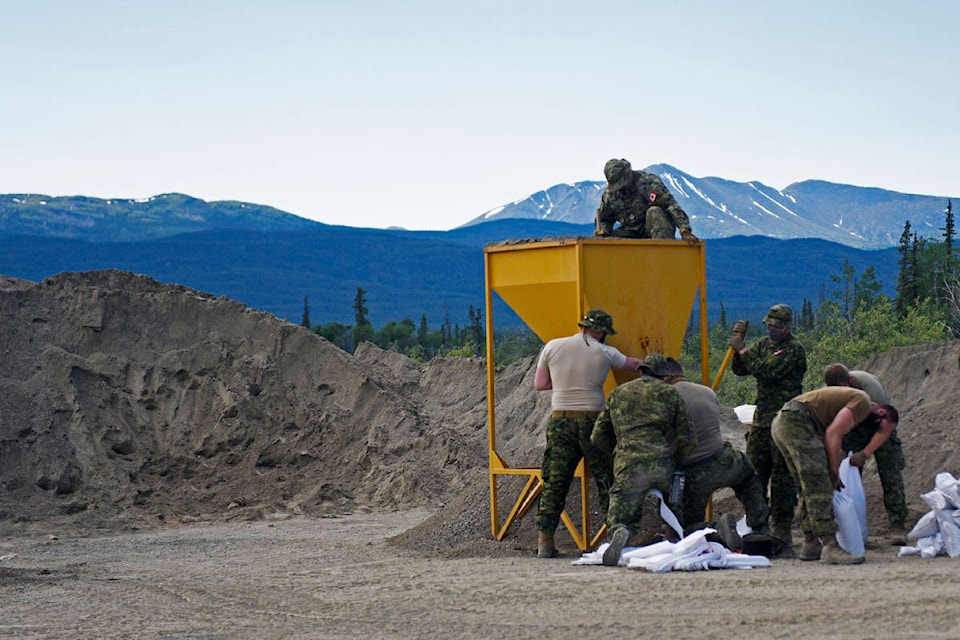Water levels are slowly dropping in the Southern Lakes region, but emergency services and residents are preparing for a possible higher peak in mid-August.
“While cooler weather just recently has led to a slight drop in the water levels with the southern basin, we remain diligent,” said Diarmuid O’Donovan, the Yukon government’s emergency measures organization director, in an update on July 20.
“We will likely have to maintain a wary eye for about another month, as we monitor these levels,” he said.
Senior hydrologist Holly Goulding said a low forecast of precipitation for the remainder of July could indicate that the final water levels will peak lower than expected, but the forecast is not precise.
Goulding said Bennett, Tagish and Marsh lakes are around five to 13 centimetres above 2007 levels and water levels on the Southern Lakes have been dropping since last weekend. They are now dropping from the peak, which was seen around July 10.
Water levels on Lake Laberge are just over 39 cm above 2007 levels and are also in decline.
In the short term, water levels are expected to remain high but continue slowly dropping. Rainfall and temperatures will continue to influence water levels. Yukon Energy’s current modeling still predicts a higher peak level for mid-August if rainfall returns to more seasonal amounts.
“There has been minimal rainfall in the basin since mid-June… it’s becoming more likely that we’ll have a lower than average July precipitation amount, which could result in a lower peak water level than has been predicted to date,” she said.
Goulding said 40 per cent of the high water originates from snowmelt, another 30 per cent originates from precipitation and the remaining 30 per cent from glacier melt.
The mid-August peak is expected to be 20 cm to 83 cm above 2007 levels on Marsh Lake.
Flood liaison Mark Hill said emergency services are preparing for the highest projected flood level as they continue to build up berms to protect property. Berms are built considering both projected height of water and impact of waves, said Hill.
“We’re doing everything in our power to ensure that our flood mitigation efforts are going to be able to deal with whatever rise in water presents itself,” he said. “The emergency teams are pretty conservative by nature. So if somebody says that this is the absolute maximum height of the water we predict could be, we’re gonna build to that and then even above.”
In total, Hill listed off around 185 properties in different areas of the Southern Lakes that are affected by flooding. Army Beach, South McClintock and Deep Creek are the hardest hit.
“I wanted to reassure residents that crews are working diligently; they’re working very hard in all areas impacted by flooding,” said Hill.
A “super berm” constructed of very large sandbags has been completed near Carcross to ensure the highway remains passable. An engineering assessment has also been completed on the bridge.
Hill said the Canadian Forces personnel who have been contributing to the flood relief, as well as the heavy equipment brought in, will remain in the Southern Lakes. Some of the soldiers will be rotated out with fresh crews coming in from Edmonton.
“Right now they remain on task and we’re grateful for the support that the federal government has provided,” he said.
One evacuation order remains for one property in Shallow Bay. Evacuation alerts remain in place. Yukoners are also asked to stay off roads where work is ongoing, minimize wakes and avoid being close to shore when boating and to be extra careful on rivers.
Post-flood response
Officials said July 20 that the government is looking at the last major flooding event in 2007 for lessons learned from recovery and cleanup. The government will also be looking ahead to the future as climate change makes extreme weather events more likely.
“I’ll say that increasing resiliency is always one of our objectives here,” said O’Donovan. “I think the reality is we are seeing the effects of climate change writ large. I wouldn’t say that this year is down necessarily to a specific element of climate change but as temperatures warm, it’s going to lead to conditions whereby the air mass holds that much more precipitation, which means that we might see bigger rain events in summer and bigger snow events in winter. That, in turn, of course, will affect the water levels of the experience the rest of the year,” he said.
“It does point to the fact that we do need to make sure that we have plans and preparations in place for this changing climate,” he said.
Contact Haley Ritchie at haley.ritchie@yukon-news.com
